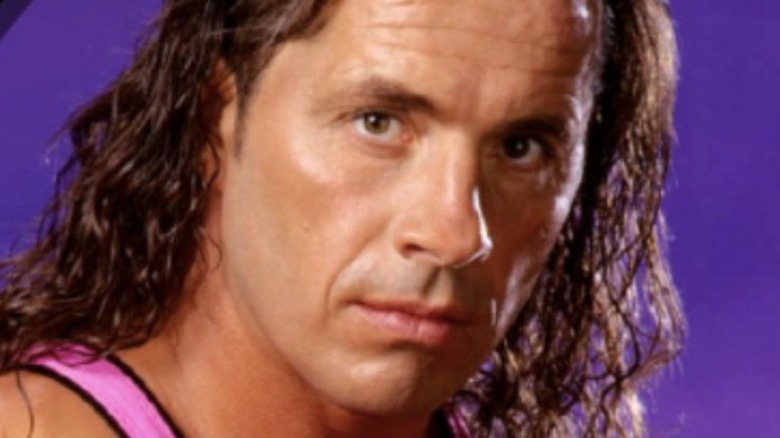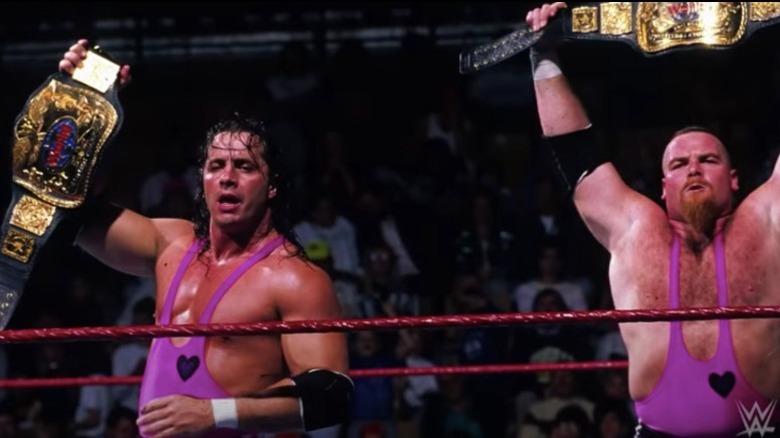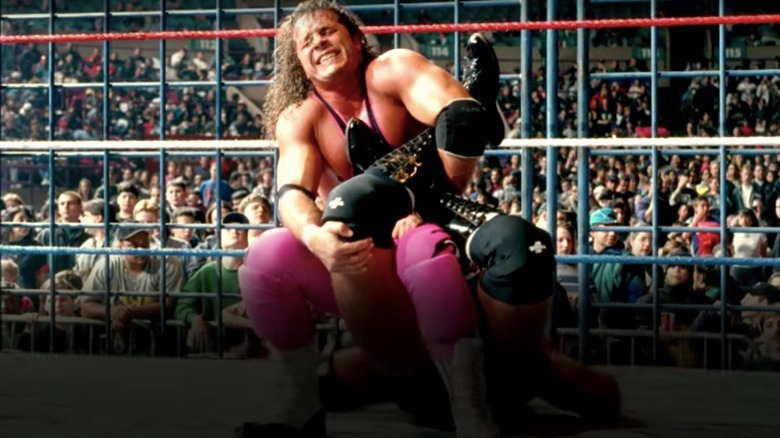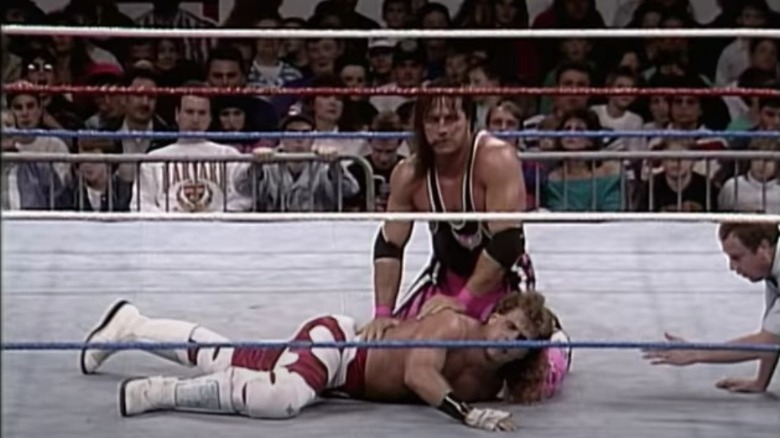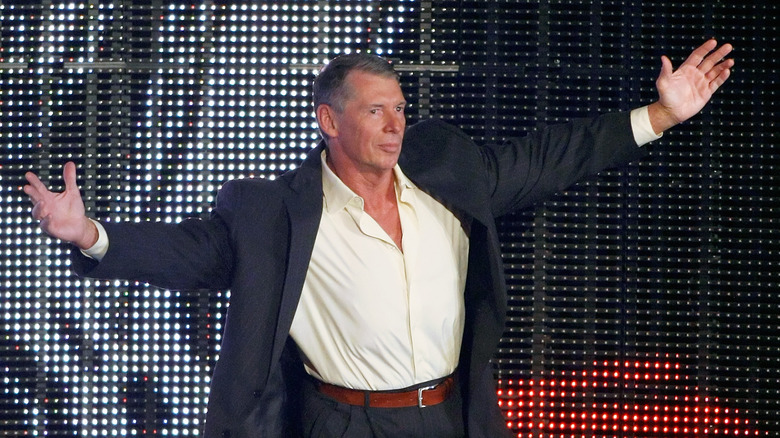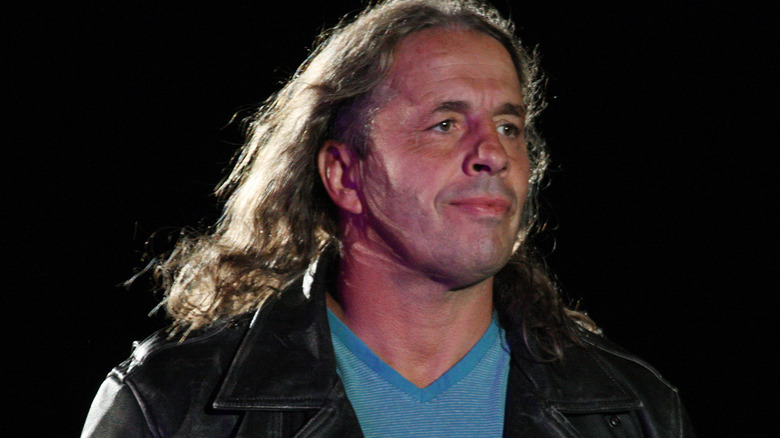The Untold Truth Of Bret Hart
Pro wrestling fans respect Bret "The Hitman" Hart as one of the greatest to ever don neon spandex and enter the ring. But in his own opinion, the wrestler's greatness was second to none. According to his WWE bio, Hart boldly claimed that he was "the best there is, the best there was, and the best there ever will be." And he definitely had the accolades to put some weight behind those words. Over the course of his career that spanned nearly three decades, Hart racked up several top prizes, including a pair of WWE Intercontinental Championships and five WWE Titles, and ignited some of the sport's bitterest rivalries.
One thing that set the Hitman apart from the wrestlers he faced in the ring was his dedication to precision and safety. He brags on his official website that in all his years of wrestling, he never actually harmed any of his opponents, an aspect of his athleticism that earned him the nickname "The Excellence of Execution." Hart's celebrated career in the squared circle will be remembered on Biography's "WWE Legends," airing at 8/7 Central on May 23 on A&E. Let's take a look back at the life and legacy of one of the sport's most memorable characters.
Bret Hart's entrance into the WWE was a family affair
Bret Hart got his start in pro wrestling in 1976 in Stampede Wrestling, a promotion in his hometown of Calgary, Alberta, Canada. During his time with before the WWE, he had some memorable matches with wrestlers like the Dynamite Kid and Tiger Mask, of New Japan Pro Wrestling. In 1984, Stampede was swallowed up by the WWE (then the WWF) as it began its process of acquiring smaller promotions to eventually become the global behemoth that it is today. According to his Pro Wrestling Fandom wiki, the fat cats at the WWE wanted him to wrestle as a cowboy character, but Hart had too much respect for cowpokes to caricature one on TV. He reportedly said that in Alberta "if you say you're a cowboy, you'd better be one."
So instead, he joined forces with his brother-in-law Jim "The Anvil" Neidhart (pictured above, at right) to form the legendary tag team known as The Hart Foundation. Hart's surgical precision was the perfect contrast to Neidhart's brute strength. The two took the WWE by storm in the mid-1980s, winning a pair of Tag Team Championships as heels (bad guys), before turning face (good guys) and taking on the nickname "The Pink and Black Attack." They continued to have success together through the end of the decade, but Hart began to wrestle solo more and more. Despite the popularity of The Hart Foundation, he finally went solo in 1991.
Hart's signature move: the Sharpshooter
As Fandom notes, Hart's first notable success as a solo wrestler was at the 1991 SummerSlam event, where he took the WWF Intercontinental Championship after defeating "Mr. Perfect" Curt Henning with his signature move, the Sharpshooter. The move is a submission hold in which Hart crossed his opponent's legs over each other, then turned him over to bend his back until submission. After his win over Mr. Perfect, Hart went on to use the move as his classic finisher, giving it the most popular name by which it is known. It has also been called the Boston crab, the Scorpion Deathlock, and the cloverleaf leg-lace, among others, but it's most commonly known as the Sharpshooter.
However, Hart did not invent the move. According to the WWE, that distinction goes to Riki Choshu of New Japan Pro Wrestling. Choshu invented the move years before Hart popularized it in American rings. The move has also been used with variations by wrestlers like Sting, The Rock, Edge, and others. But although it helped launch Hart to worldwide fame, it would also be a critical part of the most controversial moment in the Hitman's career.
Bret Hart's biggest pro wrestling rivalries
His big win over Mr. Perfect was just the beginning of one of Hart's most action-packed rivalries in the WWE. According to 411 Mania, they would go on to face each other again in King of the Ring in 1993, and their rivalry even spilled over into the WCW. But other wrestlers in the WWE had it out for Hart, as well, and the Hitman would go on to be a part of some of the most famous rivalries in the sport's history. One such match-up was with Japanese behemoth Yokozuna, who took Hart down at WrestleMania 9, but would lose the title to the Hitman the following year. Another of Hart's fiercest opponents was his own brother, Owen. The fact that they were real brothers lent believability to the kayfabe aspect of their in-ring rivalry.
The Hitman had notable rivalries with other superstars like Jerry Lawler, Davey Boy Smith, and Stone Cold Steve Austin, but his truly legendary feud was with Shawn Michaels (pictured above, in an armlock). The rivalry was the most important of both wrestlers' careers, as they vied for the spotlight as the face of the promotion. This honor would ultimately go to Steve Austin, and the rivalry between the Hitman and the Heartbreak Kid would come to an end in truly scandalous fashion.
Vince McMahon cheated to take the title from Hart
Toward the end of 1997, Hart was about to leave the WWF for the WCW, and this posed a problem for Vince McMahon. He didn't want one of his biggest stars going to his biggest competitor with the belt around his waist. So he aimed to have Shawn Michaels take it from Hart during a pay-per-view match in Montreal. But Hart wasn't happy with the idea of losing the title on what was essentially his home turf, Canada. As Fandom notes, the disagreement led to what some recall as the most controversial moment in pro wrestling history, a match known as the Montreal Screwjob. The match saw Shawn Michaels put Hart in the Hitman's own signature move. What happened next shocked Hart, the fans, and the pro wrestling world at large.
Vince McMahon had the referee call the match while Michaels had Hart in the Sharpshooter, even though Hart hadn't tapped out. Hart and the crowd were furious. The Hitman even spit in the face of his newly former boss. Michaels grabbed the championship belt and scurried out of the arena. But for Michaels, the victory was bittersweet. "From a professional standpoint, reputation standpoint, even though I wasn't the most lovable guy back then, it was still just an absolute miserable day, [a] very uncomfortable day," he told ESPN in 2019. The Montreal Screwjob remains one of the most controversial things the WWE has ever done.
Injuries finally forced Bret Hart to retire
Bret Hart's career met its end the way so many wrestling careers do. His body just couldn't take it any longer. According to The Columbus Dispatch, the Hitman spoke of his history of injuries at a neuroscience symposium in 2019. He recounted a pay-per-view match with Goldberg in 1999 that pretty much sealed his fate. "One of the last things I said to Bill before I walked out to the ring was, 'Don't hurt me,'" Hart said. "I wish he heard me a little better." Unlike Hart, Goldberg had a penchant for injuring opponents, and in that bout Hart took several direct hits and a nasty kick to the head. Still, Hart continued to wrestle for two weeks after that fight. He said he was angry with himself after his final fight, in which Sycho Sid slammed him to the mat. "I remember when I hit the ground, I could see a million stars."
Doctors diagnosed Hart with a severe concussion. He also had a serious muscle tear in his neck. It took him two years to fully recover. He made a couple returns to the ring in subsequent years, including an encounter with Michaels in 2010 in which the two were able to bury the hatchet, but his career was effectively over in 2000. Hart suffered a stroke in 2002, and has served as the spokesman for March of Dimes Canada's stroke recovery program ever since.
